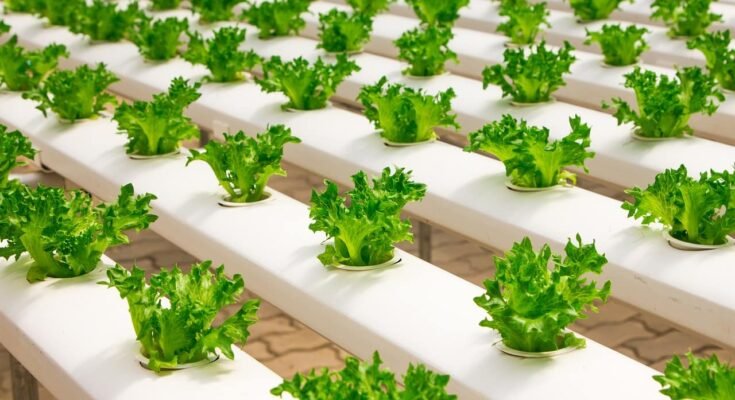Introduction
As the world faces increasing challenges in food production due to limited land availability, climate change, and urbanization, innovative agricultural solutions have emerged to ensure food security.
One of the most promising approaches is hydroponics, a method of growing plants without soil.
Alpha Hydroponics is at the forefront of this innovation, offering a future-ready solution to indoor farming.
This article will explore Alpha Hydroponics’ principles, advantages, systems, and potential for revolutionizing food growth.
Whether you are a beginner or an experienced grower, this guide will help you understand why Alpha Hydroponics is essential for the future of agriculture.
What is Alpha Hydroponics?
Alpha Hydroponics is a modern agricultural method where plants are grown in a nutrient-rich water solution rather than soil.
This technique allows for greater control over the plant’s environment, ensuring optimal growth conditions, higher yields, and more efficient use of water and nutrients.
Key Features of Alpha Hydroponics:
- Soilless cultivation: Plants are grown in water or inert mediums like coconut coir, rock wool, or perlite.
- Nutrient solutions: The plant roots are directly exposed to a nutrient-rich water solution, providing essential minerals for growth.
- Controlled environment: Indoor environments allow growers to regulate temperature, humidity, light, and airflow, minimizing the risks associated with outdoor farming.
- Water efficiency: Hydroponics systems use up to 90% less water than traditional farming methods, making it ideal for areas with water scarcity.
The Science Behind Alpha Hydroponics
At the core of Alpha Hydroponics is the principle of controlled environment agriculture (CEA). By optimizing all aspects of plant growth—from nutrient delivery to environmental conditions. This technique ensures plants receive precisely what they need when they need it. Here are some critical components of how Alpha Hydroponics works:
Nutrient Solutions
The nutrient solution used in Alpha Hydroponics is carefully crafted to include essential elements like nitrogen, phosphorus, potassium, calcium, and magnesium.
This allows for faster plant growth and higher yields compared to traditional farming.
Water and pH Management
Water is vital in hydroponics, and its quality is closely monitored. The pH level of the water is also crucial, as plants require specific pH levels (typically between 5.5 and 6.5) to absorb nutrients efficiently.
Lighting Systems
In indoor farming, natural sunlight is replaced by artificial lighting systems, such as LED grow lights, that mimic the sun’s spectrum. These lights give plants the exact amount of light they need for photosynthesis and growth.
Growth Mediums
While soil is not used in hydroponics, growers use alternative growing mediums like perlite, vermiculite, rock wool, or coconut coir. These mediums support the plant’s roots and allow better water and air circulation.
Benefits of Alpha Hydroponics
Adopting Alpha Hydroponics offers numerous benefits to both commercial and home growers. Some of the key advantages include:
Space Efficiency
Alpha Hydroponics systems are perfect for urban areas with limited space. Vertical farming techniques allow growers to maximize space by stacking plants in layers and more effectively utilizing small regions.
Faster Growth Rates
Plants in Alpha Hydroponics systems grow up to 50% faster than traditional soil-based plants. This is due to the constant access to nutrients and water, reducing the time required for plant development.
Year-Round Production
Since Alpha Hydroponics is often practiced indoors, it is not subject to seasonal changes. Growers can produce crops year-round, ensuring a consistent supply of fresh produce.
Reduced Water Usage
Water is recycled within hydroponic systems, making Alpha Hydroponics one of the most water-efficient farming methods. This is particularly valuable in regions facing water shortages.
Fewer Pesticides
Because indoor hydroponic systems are protected from pests and diseases commonly found in soil, pesticide use is significantly reduced, resulting in cleaner and healthier produce.
Higher Yields
The optimized growing conditions in Alpha Hydroponics systems lead to higher yields than traditional farming methods. This makes it ideal for commercial growers looking to maximize productivity.
Types of Alpha Hydroponic Systems
Several hydroponic systems can be used in Alpha Hydroponics, each with advantages. Here are the most common systems:
Deep Water Culture (DWC)
In this system, plant roots are suspended in a nutrient solution, allowing constant access to water, oxygen, and nutrients. DWC is simple and ideal for beginners.
Nutrient Film Technique (NFT)
NFT systems involve a shallow stream of nutrient-rich water flowing over the roots of plants. The continuous flow ensures the plants receive a steady supply of nutrients while promoting aeration.
Ebb and Flow (Flood and Drain)
The grow tray is periodically flooded with a nutrient solution and drained in this system. This process provides oxygen to the roots while ensuring they remain hydrated and nourished.
Drip System
A drip system delivers nutrient solutions directly to the base of each plant through a network of tubes. This system allows for precise control over nutrient delivery and is commonly used in commercial setups.
Aeroponics
Aeroponics systems suspend plant roots in the air, misting them with a nutrient solution. This method maximizes oxygen exposure to the roots, leading to faster growth rates and higher yields.
Setting Up an Alpha Hydroponics System
Starting an Alpha Hydroponics system can be an exciting project. Whether you’re a home gardener or a commercial grower, here are the basic steps for setting up your system:
Choose Your Hydroponic System
Decide which solution best fits your demands and available space. A deep water culture or nutrient film technique system is the easiest for beginners.
Select the Right Growth Medium
Depending on your system, choose an appropriate growth medium such as coconut coir, rock wool, or perlite.
Prepare the Nutrient Solution
Ensure the nutrient solution is mixed according to your plant’s needs. It should contain all essential macro and micronutrients.
Install the Lighting System
For indoor systems, install a reliable lighting setup using LED grow lights. Ensure the plants have the correct quantity of light for where they are in their growth cycle.
Monitor pH and Water Levels.
Check the water’s pH regularly to ensure it is within the optimal range for plant growth. Additionally, maintain the water level in the system to avoid root drying.
Best Crops for Alpha Hydroponics
Many crops thrive in Alpha Hydroponic systems. Some of the best options include:
- Lettuce: One of the easiest and fastest-growing crops in hydroponics.
- Tomatoes: Hydroponic tomatoes grow faster and yield more fruit than soil-grown varieties.
- Herbs: Basil, mint, and parsley are excellent choices for hydroponic systems.
- Strawberries: Grow well in vertical hydroponic setups and can yield fresh fruit year-round.
- Cucumbers: Ideal for larger systems, cucumbers proliferate in hydroponic environments.
Challenges and Solutions in Alpha Hydroponics
While Alpha Hydroponics offers numerous benefits, growers may face some challenges. The following are some typical problems and how to fix them:
Nutrient Imbalances
Over or under-fertilizing can lead to poor plant growth. Solution: Monitor the nutrient levels regularly and adjust the solution as needed.
Disease Control
Without soil, plants are still vulnerable to waterborne diseases. Solution: Maintain a clean environment, sanitize equipment, and use appropriate water filtration systems.
Power Outages
Hydroponic systems rely on pumps and lights. Solution: Invest in backup generators or battery systems to prevent system failures during outages.
The Future of Alpha Hydroponics
The demand for innovative farming solutions will increase as the global population grows. Alpha Hydroponics is poised to play a significant role in shaping the future of agriculture.
With advances in technology, the efficiency and productivity of these systems will only improve, making them an essential component of sustainable food production.
FAQ: Alpha Hydroponics
Q1: What is Alpha Hydroponics?
Alpha Hydroponics is a method of growing plants without soil. It uses nutrient-rich water solutions to provide essential minerals for plant growth.
Q2: What are the benefits of Alpha Hydroponics?
Alpha Hydroponics offers faster growth rates, higher yields, water efficiency, space-saving solutions, and the ability to grow crops year-round.
Q3: What crops can be grown in Alpha Hydroponics?
Crops like lettuce, tomatoes, strawberries, herbs, and cucumbers are ideal for hydroponic systems.
Q4: What types of Alpha Hydroponic systems are there?
Several systems are available, including Deep Water Culture, Nutrient Film Technique, Ebb and Flow, Drip Systems, and Aeroponics.
Q5: Is Alpha Hydroponics suitable for beginners?
Yes, Alpha Hydroponics offers various simple systems like Deep Water Culture, which
Conclusion
In conclusion, Alpha Hydroponics represents a groundbreaking advancement in modern agriculture, offering innovative solutions to the growing challenges of food production. With its ability to provide efficient, space-saving, and water-conserving farming techniques.
Alpha Hydroponics is well-positioned to shape the future of indoor farming. From the precise control over plant growth environments to the ability to produce higher yields with fewer resources, this method opens up new possibilities for urban and rural farmers alike.
As global populations rise and the need for sustainable food production increases, Alpha Hydroponics offers a viable, scalable, and environmentally friendly alternative to traditional farming.
Its adaptability to different crop types, easy setup options for beginners, and the potential for commercial success make it an essential tool in the future of agriculture.
Whether you’re looking to grow your food at home or scale up commercial production, Alpha Hydroponics promises to revolutionize how we grow food sustainably for future generations.


